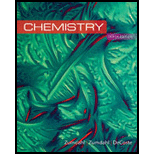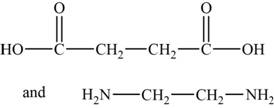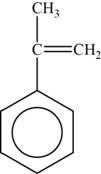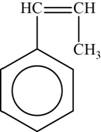
(a)
Interpretation: The monomers of the given
Concept introduction: The polymers (repeating structural units) are derived from the simple and reactive molecules, called as monomers. Depending upon the mode of
(a)
Answer to Problem 78E
Answer
The monomer is vinyl fluoride. It is an
Explanation of Solution
Explanation
To determine: The monomer of the given polymer.
The monomer is vinyl fluoride. It is an addition polymer whose structure is shown in Figure 1.
The structure of the monomer is,

Figure 1
The polymer contains a repeating chain of vinyl fluoride, which on adding polymerization forms a polymer known as polyvinyl fluoride. Hence, the monomer is vinyl fluoride.
(b)
Interpretation: The monomers of the given polymers, their classification (condensation or addition polymers) and copolymers are to be stated.
Concept introduction: The polymers (repeating structural units) are derived from the simple and reactive molecules, called as monomers. Depending upon the mode of polymerization, polymerization mainly occurs by the addition and condensation polymerization reactions. Copolymers are defined as polymers in which repeating structural units are derived from two or more types of monomers.
(b)
Answer to Problem 78E
Answer
The monomer is
Explanation of Solution
Explanation
To determine: The monomer of the given polymer.
The monomer is
The structure of the monomer is,

Figure 2
The polymer contains a repeating chain of
(c)
Interpretation: The monomers of the given polymers, their classification (condensation or addition polymers) and copolymers are to be stated.
Concept introduction: The polymers (repeating structural units) are derived from the simple and reactive molecules, called as monomers. Depending upon the mode of polymerization, polymerization mainly occurs by the addition and condensation polymerization reactions. Copolymers are defined as polymers in which repeating structural units are derived from two or more types of monomers.
(c)
Answer to Problem 78E
Answer
The monomers are
Explanation of Solution
Explanation
To determine: The monomer of the given polymer.
The monomers are
The structures of the monomers are,

Figure 3
The polymer chain consists of the repeating units of ethane on which carboxylic group is present on carbon 1 and 2 respectively indicates that one monomer is
(d)
Interpretation: The monomers of the given polymers, their classification (condensation or addition polymers) and copolymers are to be stated.
Concept introduction: The polymers (repeating structural units) are derived from the simple and reactive molecules, called as monomers. Depending upon the mode of polymerization, polymerization mainly occurs by the addition and condensation polymerization reactions. Copolymers are defined as polymers in which repeating structural units are derived from two or more types of monomers.
(d)
Answer to Problem 78E
Answer
The monomer is
Explanation of Solution
Explanation
To determine: The monomer of the given polymer.
The monomer is
The structure of the monomer is,

Figure 4
The repeating unit of polymer has
(e)
Interpretation: The monomers of the given polymers, their classification (condensation or addition polymers) and copolymers are to be stated.
Concept introduction: The polymers (repeating structural units) are derived from the simple and reactive molecules, called as monomers. Depending upon the mode of polymerization, polymerization mainly occurs by the addition and condensation polymerization reactions. Copolymers are defined as polymers in which repeating structural units are derived from two or more types of monomers.
(e)
Answer to Problem 78E
Answer
The monomer is
Explanation of Solution
Explanation
To determine: The monomer of the given polymer.
The monomer is
The structure of the monomer is,

Figure 5
The repeating unit of polymer has
(f)
Interpretation: The monomers of the given polymers, their classification (condensation or addition polymers) and copolymers are to be stated.
Concept introduction: The polymers (repeating structural units) are derived from the simple and reactive molecules, called as monomers. Depending upon the mode of polymerization, polymerization mainly occurs by the addition and condensation polymerization reactions. Copolymers are defined as polymers in which repeating structural units are derived from two or more types of monomers.
(f)
Answer to Problem 78E
Answer
The monomer are
Explanation of Solution
Explanation
To determine: The monomer of the given polymer.
The monomer are and
The structures of the monomers are,

Figure 6
DMT is an organic compound. It is the diester formed from
Want to see more full solutions like this?
Chapter 22 Solutions
Chemistry
- Phenol is the starting material for the synthesis of 2,3,4,5,6-pentachlorophenol, known al-ternatively as pentachlorophenol, or more simply as penta. At one time, penta was widely used as a wood preservative for decks, siding, and outdoor wood furniture. Draw the structural formula for pentachlorophenol and describe its synthesis from phenol.arrow_forward12 Mass Spectrometry (d) This unknown contains oxygen, but it does not show any significant infrared absorption peaks above 3000 cm . 59 100- BO 40 Relative Abundance M(102) - 15 20 25 30 35 40 45 50 5 60 65 70 75 80 85 90 95 100 105 mizarrow_forwardDraw a Haworth projection of a common cyclic form of this monosaccharide: H HO H HO H HO H H -OH CH2OH Click and drag to start drawing a structure. Х : Darrow_forward
- : Draw the structure of valylasparagine, a dipeptide made from valine and asparagine, as it would appear at physiological pH. Click and drag to start drawing a structure. P Darrow_forwardDraw the Haworth projection of α-L-mannose. You will find helpful information in the ALEKS Data resource. Click and drag to start drawing a structure. : ཊི Х Darrow_forwardDraw the structure of serine at pH 6.8. Click and drag to start drawing a structure. : d كarrow_forward
- Take a look at this molecule, and then answer the questions in the table below it. CH2OH H H H OH OH OH CH2OH H H H H OH H H OH H OH Is this a reducing sugar? yes α β ロ→ロ no ☑ yes Does this molecule contain a glycosidic bond? If you said this molecule does contain a glycosidic bond, write the symbol describing it. O no 0+0 If you said this molecule does contain a glycosidic bond, write the common names (including anomer and enantiomer labels) of the molecules that would be released if that bond were hydrolyzed. If there's more than one molecule, separate each name with a comma. ☐arrow_forwardAnswer the questions in the table below about this molecule: H₂N-CH₂ -C—NH–CH–C—NH–CH—COO- CH3 CH CH3 What kind of molecule is this? 0= CH2 C If you said the molecule is a peptide, write a description of it using 3-letter codes separated ☐ by dashes. polysaccharide peptide amino acid phospolipid none of the above Хarrow_forwardDraw a Haworth projection of a common cyclic form of this monosaccharide: CH₂OH C=O HO H H -OH H OH CH₂OH Click and drag to start drawing a structure. : ☐ Х S '☐arrow_forward
- Nucleophilic Aromatic Substitution 22.30 Predict all possible products formed from the following nucleophilic substitution reactions. (a) (b) 9 1. NaOH 2. HCI, H₂O CI NH₁(!) +NaNH, -33°C 1. NaOH 2. HCl, H₂Oarrow_forwardSyntheses 22.35 Show how to convert toluene to these compounds. (a) -CH,Br (b) Br- -CH3 22.36 Show how to prepare each compound from 1-phenyl-1-propanone. 1-Phenyl-1-propanone ہتی. Br. (b) Br (racemic) 22.37 Show how to convert ethyl benzene to (a) 2,5-dichlorobenzoic acid and (b) 2,4-dichlorobenzoic acid. 22.38 Show reagents and conditions to bring about the following conversions. (a) 9 NH2 8 CO₂H NH2 CO₂Et (d) NO2 NH2 S NH₂ NO2 CHS CHarrow_forwardive the major organic product(s) of each of the following reactions or sequences of reactions. Show all rant stereochemistry. [10 only] A. B. NaN3 1. LiAlH4, ether Br 2. H₂O CH3 HNO3 H₂/Pt H₂SO ethanol C. 0 0 CH3CC1 NaOH NHCCH AICI H₂O . NH₂ CH3CH2 N CH2CH3 + HCI CH₂CH 3 1. LIAIH, THE 2. H₂Oarrow_forward
 Introductory Chemistry: An Active Learning Approa...ChemistryISBN:9781305079250Author:Mark S. Cracolice, Ed PetersPublisher:Cengage Learning
Introductory Chemistry: An Active Learning Approa...ChemistryISBN:9781305079250Author:Mark S. Cracolice, Ed PetersPublisher:Cengage Learning EBK A SMALL SCALE APPROACH TO ORGANIC LChemistryISBN:9781305446021Author:LampmanPublisher:CENGAGE LEARNING - CONSIGNMENT
EBK A SMALL SCALE APPROACH TO ORGANIC LChemistryISBN:9781305446021Author:LampmanPublisher:CENGAGE LEARNING - CONSIGNMENT World of Chemistry, 3rd editionChemistryISBN:9781133109655Author:Steven S. Zumdahl, Susan L. Zumdahl, Donald J. DeCostePublisher:Brooks / Cole / Cengage Learning
World of Chemistry, 3rd editionChemistryISBN:9781133109655Author:Steven S. Zumdahl, Susan L. Zumdahl, Donald J. DeCostePublisher:Brooks / Cole / Cengage Learning Chemistry: Principles and PracticeChemistryISBN:9780534420123Author:Daniel L. Reger, Scott R. Goode, David W. Ball, Edward MercerPublisher:Cengage Learning
Chemistry: Principles and PracticeChemistryISBN:9780534420123Author:Daniel L. Reger, Scott R. Goode, David W. Ball, Edward MercerPublisher:Cengage Learning Chemistry: The Molecular ScienceChemistryISBN:9781285199047Author:John W. Moore, Conrad L. StanitskiPublisher:Cengage LearningChemistry: Matter and ChangeChemistryISBN:9780078746376Author:Dinah Zike, Laurel Dingrando, Nicholas Hainen, Cheryl WistromPublisher:Glencoe/McGraw-Hill School Pub Co
Chemistry: The Molecular ScienceChemistryISBN:9781285199047Author:John W. Moore, Conrad L. StanitskiPublisher:Cengage LearningChemistry: Matter and ChangeChemistryISBN:9780078746376Author:Dinah Zike, Laurel Dingrando, Nicholas Hainen, Cheryl WistromPublisher:Glencoe/McGraw-Hill School Pub Co





